The Cattle Blower Market is estimated to be valued at USD 285.0 million in 2025 and is projected to reach USD 468.7 million by 2035, registering a compound annual growth rate (CAGR) of 5.1% over the forecast period.
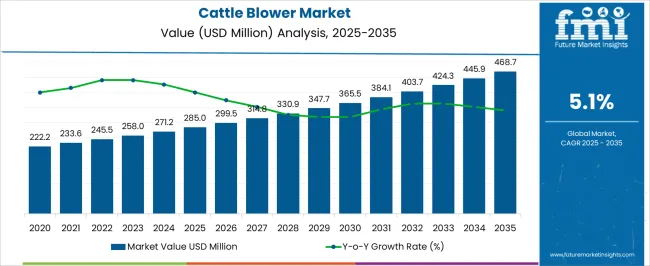
| Metric | Value |
|---|---|
| Cattle Blower Market Estimated Value in (2025 E) | USD 285.0 million |
| Cattle Blower Market Forecast Value in (2035 F) | USD 468.7 million |
| Forecast CAGR (2025 to 2035) | 5.1% |
The Cattle Blower market is demonstrating significant growth as livestock grooming and hygiene practices evolve with modern farming standards. Demand is being reinforced by increased awareness about animal welfare and the role of proper grooming in ensuring optimal cattle health and productivity. According to industry news and manufacturer updates, commercial and private cattle operations are investing in blower systems to streamline grooming and drying processes, particularly in regions with variable climate conditions.
In addition, statements from agricultural equipment firms suggest that newer blower technologies are designed with energy efficiency, noise reduction, and ergonomic operation in mind, enhancing their appeal to end users. Future growth is anticipated as livestock shows, dairy farms, and meat producers continue integrating advanced equipment to improve efficiency and meet regulatory standards.
Advancements in motor performance and pressure regulation, along with expanding availability through online and retail channels, are further contributing to the market's upward trajectory These combined drivers are creating a solid foundation for continued adoption across the livestock sector.
The market is segmented by Type, Motor, and Application and region. By Type, the market is divided into High Pressure, Low Pressure, and Medium Pressure. In terms of Motor, the market is classified into Two Motor and One Motor. Based on Application, the market is segmented into Grooming and Insect Removal. Regionally, the market is classified into North America, Latin America, Western Europe, Eastern Europe, Balkan & Baltic Countries, Russia & Belarus, Central Asia, East Asia, South Asia & Pacific, and the Middle East & Africa.
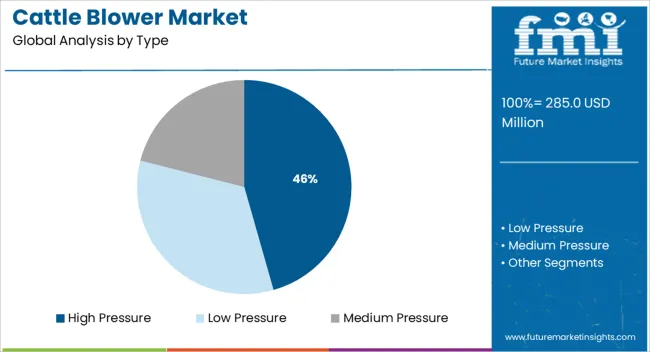
The high pressure type segment is expected to hold 45.6% of the Cattle Blower market revenue share in 2025, positioning it as the leading type. This prominence has been supported by its effectiveness in quickly removing moisture and debris from cattle coats, which significantly reduces grooming time and labor input. As noted in agricultural equipment updates and manufacturer communications, high pressure blowers are being favored for their superior airflow capabilities and ability to handle dense or long coats often found in show cattle or colder climates.
The segment's growth is further driven by demand from commercial farms seeking to improve grooming efficiency while maintaining high hygiene standards. Improvements in safety features and usability have also contributed to wider adoption among smaller operations.
Additionally, the ability of high pressure blowers to maintain consistent performance under extended use conditions has made them a preferred choice in professional livestock grooming environments These operational and performance advantages have helped sustain the segment’s leadership in 2025.
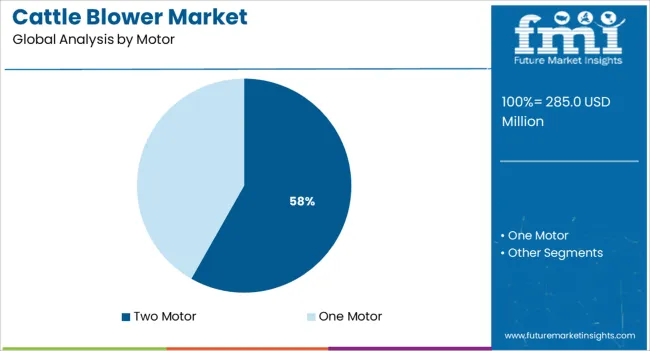
The two motor segment is projected to account for 58.2% of the Cattle Blower market revenue share in 2025, making it the dominant motor type. This leadership is being driven by the segment's ability to deliver higher airflow and faster drying performance, which has become critical for grooming large herds or during livestock events.
Equipment manufacturer briefings and product demonstrations have emphasized that two motor systems offer enhanced control over speed and pressure, enabling tailored grooming based on cattle breed and coat thickness. These systems are also being adopted for their durability and energy efficiency, which address both economic and environmental concerns of commercial users.
Furthermore, user feedback highlighted in agricultural forums points to lower drying times and improved grooming results, which contribute to animal comfort and ease of handling The segment’s strong performance, adaptability, and alignment with both high-demand and specialized grooming needs have supported its leading market share in 2025.
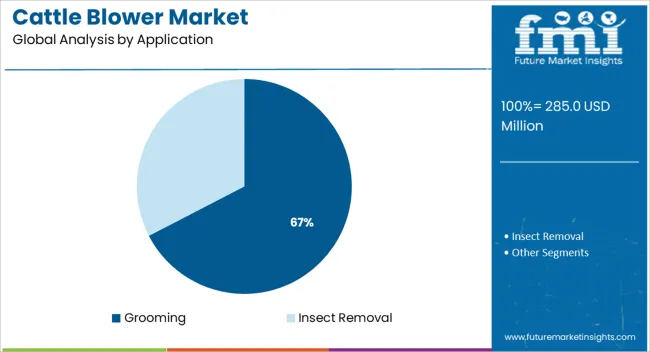
The grooming application segment is anticipated to contribute 67.4% of the Cattle Blower market revenue share in 2025, securing its position as the largest application. This segment’s dominance is being shaped by rising emphasis on cattle presentation, health, and hygiene, especially in dairy, show, and breeding operations. Press releases from agricultural supply firms have reported increased investment in grooming solutions that help improve cattle appearance and reduce risks of skin infections and matting.
In addition, livestock show circuits and breed associations have increasingly promoted high grooming standards, indirectly supporting adoption of advanced blower systems. The grooming process has also become more critical during seasonal changes, when moisture control directly impacts cattle comfort and health.
Enhanced blower technologies are allowing farm operators to perform grooming more efficiently with consistent results, thereby reducing stress on the animals and staff These operational, health-related, and compliance-based factors have contributed significantly to the strong position of the grooming segment in 2025.
One of the main elements likely to foster a favorable outlook for the market is the substantial expansion of the cattle sector globally. Farm owners can profit from cattle farming equipment like cattle blowers in the form of increased operational effectiveness and enhanced animal management. They are anticipated to install automation technology as a result of rising labor expenses in nations like India, China, Germany, and the United Kingdom.
In reaction to increased labor costs, the desire for automated livestock farms is likely to increase, creating new market prospects for cattle blowers. Moreover, farmers are focusing on using cutting-edge technology in farming to improve operational effectiveness. This trend of using advanced farming equipment to boost total production and management techniques is accelerating market expansion.
Market players provide a range of animal drier models that are appropriate for various user types. The integration of features like speed control, heat control switches, and temperature setting choices as a result of technological improvements aids in maintaining constant precision in temperature.
Additionally, these businesses provide consumers with tailored services that let them choose the equipment that is most appropriate for their requirements. Certain cattle dryers include an advanced control panel that makes it simple to change the temperature and airflow. It guarantees that the animals will dry fast and effectively.
| Attributes | Details |
|---|---|
| Cattle Blower Market Value (2025) | USD 285.0 million |
| Cattle Blower Market Expected Value (2035) | USD 468.7 million |
| Cattle Blower Market Projected CAGR (2025 to 2035) | 5.1% |
The cattle blower market is projected to expand at 5.1% CAGR between 2025 and 2035. Historically, the market value of cattle blowers presented slow-paced development from 2020 to 2025, registering a CAGR of 4.6%.
Over the projected period, the market for cattle blowers is anticipated to expand moderately. The market is expanding due to the demand for automation in a variety of animal husbandry procedures. Additionally, the market is positively impacted by rising industrialization, increased product uptake, particularly in developed nations, and the growth of the agricultural sector.
| Historical CAGR (2020 to 2025) | 4.6% |
|---|---|
| Forecast CAGR (2025 to 2035) | 5.1% |
On the back of these factors, the cattle blower market is likely to grow 1.6X between 2025 and 2035. As per the analysts, a valuation of USD 468.7 million by 2035 end is estimated for the market.
| Year | Valuation |
|---|---|
| 2020 | USD 187.8 Million |
| 2024 | USD 234.8 Million |
| 2025 | USD 245.5 Million |
| 2025 | USD 258 Million |
| 2035 | USD 468.7 Million |
North America is anticipated to have a dominating position in the global cattle blower market. The region is witnessing rapid technological advances and the widespread use of livestock farm equipment. The Asia Pacific cattle blower market is anticipated to expand at a rapid CAGR. The main factor is the rapid technological development that is accessible there at a lower cost than in the United States.
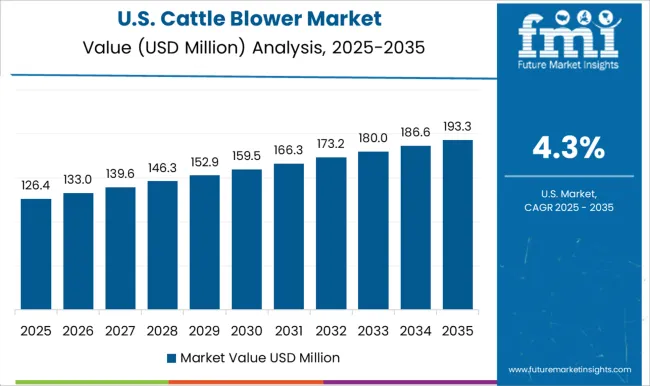
North America, which is one of the largest producers in the globe overall, includes the United States as a key producer of livestock and other products derived from animals. The adoption of cattle blowers in the USA has been influenced by the growth of dairy farms and growing labor expenses. With more hands-on experience, awareness of the use of cattle management systems has grown rapidly in recent years in the country.
| Country | United States |
|---|---|
| Market Share (2025) | 27.10% |
| Market Value (2025) | USD 66.5 Million |
In addition, this country is producing and consuming an increasing number of livestock and products made from them. Owing to this, keeping cattle in good health and hygienic conditions has become a must for livestock farmers. Additionally, a doorway for cattle blowers' adoption is opened by the rising awareness about the diseases that affect livestock and can be spread to humans. As a result, the US cattle blower market offers huge possibilities for market participants.
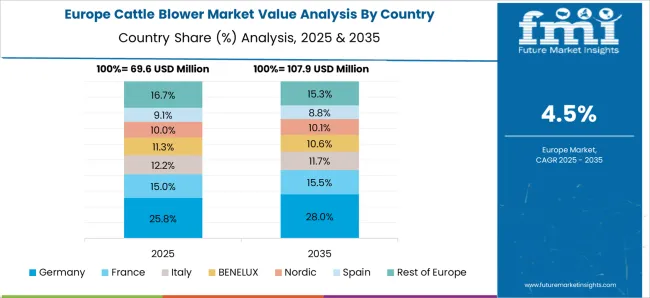
Owing to technological breakthroughs and improvements in cattle management, the German cattle blower market is the largest in all of Europe. In Germany, there is a growing demand for dairy and meat products. The fast rise in consumption is due to consumer desire for a diet rich in protein. The market is also fueled by a structured dairy industry and expanding livestock output.
| Country | Germany |
|---|---|
| Market Share (2025) | 19.60% |
| Market Value (2025) | USD 48.1 Million |
The welfare of animals is now a topic that German dairy producers are more aware of. It is predicted that this would increase the focus on managing cattle health in Germany. The German cattle blower market is expected to increase at a rapid rate throughout the forecasted period as a result.
Throughout the forecast period, the UK is anticipated to have a bigger share. It is predicted that the presence of major companies and rising agricultural machinery import and export volumes would open up the UK cattle blower market. Growing health awareness is expected to support the sector. Dairy farming in the nation is thus predicted to increase throughout the projection period. This is anticipated to enhance the use of cattle blowers along with other dairy farming machinery.
| Country | United Kingdom |
|---|---|
| CAGR (2025 to 2035) | 5.50% |
| Market Share (2025) | 9.00% |
| Market Value (2025) | USD 22.0 Million |
| Market Value (2035) | USD 37.5 Million |
Johnes Disease outbreaks in cattle are frequent occurrences in the UK. Calves must be periodically cleaned and dried correctly to protect cattle from this infection. Farmers are encouraged by this to preserve the health of the livestock. In order to tackle these ongoing disease outbreaks, cattle blower sales have been rising over the past few years.
The cattle industry in China has undergone a substantial shift. Both the domestic and international food supply, it has had a tremendous effect. The emergence of industrial livestock production techniques without land is largely to blame for this. Changes were influenced by demand and supply for new animal species, new technology, and government support.
| Country | China |
|---|---|
| CAGR (2025 to 2035) | 4.10% |
| Market Share (2025) | 9.80% |
| Market Value (2025) | USD 24.04 Million |
| Market Value (2035) | USD 35.9 Million |
A farm incident in the eastern province of Zhejiang in 2024 led to outbreaks of a crippling virus in cattle that produces a condition known as "lumpy skin disease." Cattle must be properly washed and dried on a regular basis to prevent this disease. Moreover, the country's efforts to modernize and find efficiency in its practices and organizational structure are another element likely to fuel the market's expansion. Hence, the Chinese cattle blower market is emerging as a potential market for manufacturers and suppliers.
Even though agriculture is the main source of revenue for the agricultural communities in India, the livestock industry serves as a secondary source of agriculture. It provides a reliable source of income for the district's small and marginal farmers. The majority of farmers still raise animals in conventional ways. Thus there is a substantial danger that illnesses like Amphistomiasis may spread and cause low output and productivity in livestock. Hence, the Indian cattle blower market has decent opportunities for market players.
| Country | India |
|---|---|
| CAGR (2025 to 2035) | 6.00% |
| Market Share (2025) | 3.30% |
| Market Value (2025) | USD 8.0 Million |
| Market Value (2035) | USD 14.3 Million |
India's market growth is projected to increase because of the rising need for agricultural automation and government encouragement of the expansion of the agriculture sector. Additionally, manufacturers in the cattle blower market are being given lucrative development prospects by the proliferation of e-commerce channels in India.
Since the 1960s, raising cattle for beef has grown to be a key aspect of Japanese agriculture. The most well-known beef-raising region in Japan is Matsuzaka in Mie. The globally recognized beef is only found in Japan. The excellent quality of the food they are fed and their biological characteristics are what really determine their quality. The fact that each farmer develops their own intricate procedure to raise cows to the ideal size and form after providing them with the right care. As a result, enterprises are likely to find the Japanese cattle blower market to be full of opportunities for trading.
| Country | Japan |
|---|---|
| Market Share (2025) | 5.30% |
| Market Value (2025) | USD 13.0 Million |
Currently, in Japan, the animal husbandry industry is expanding dramatically. It is projected that this would enhance demand for livestock farming equipment. As a consequence, market participants in Japan are likely to gain profit considerably.
The global market for cattle blowers is segmented based on type, motor, application, and region.
Two Motor Blowers are Mostly Preferred by Farmers
Two-motor cattle blowers are the most popular choice among farmers for sensible reasons. In comparison to single-motor blowers, two-motor blowers have a significant benefit since they are more power-efficient, can manage high flow rates, and are insensitive to changes in water depth. They essentially offer a constant flow rate regardless of back pressure, keeping the level of dissolved oxygen constant. These devices have a wide range of uses. They need little upkeep and don't require any internal changes, resulting in lengthy periods of uninterrupted operation.
Cattle Blowers are Best for Grooming
In addition to washing an animal and providing sanitary care, grooming also refers to techniques used to improve a livestock's outward look. Grooming can reveal signs of illness and symptoms, as well as assist avoid significant health problems. Animal health and wellness depend on proper grooming, which can also improve the animals' enjoyment of life. Regular grooming ensures the health and comfort of the cattle.
Growing concern for the welfare of animals is a significant reason driving up demand for cattle blowers. With many nations having a high incidence of livestock production and rising animal health spending, the market for cattle blowers has been expanding dramatically over time. People are spending more money to preserve the health of the livestock animals they own because they consider them to be part of their families and are prepared to make the necessary investments. The cost of caring for animals has increased as a result of this circumstance.
The global cattle blower market seems to be very fragmented. The market is very competitive, as evidenced by the presence of a diverse group of active manufacturers. Businesses in this sector are using a variety of strategies to stay afloat amid the intense competition. Manufacturers strive to improve the cattle blowers they now sell on the market in addition to creating new ones. Additionally, they are developing beneficial relationships with other companies operating in corresponding industries. They are forging relationships with other businesses to increase their chances of entering profitable markets.
Barn World gives customers access to the largest selection of cattle and ranch products, enabling them to discover exactly what they need to complete their tasks. Customers can discover essential livestock supplies including feeders, grain bins, cow guards, heat pads, animal shelters, storage tanks, and even sizable structures and barns within its portfolio. The business also offers its consumers the advice and assistance they require.
Since 1965, Vittetoe, Inc. has produced cattle equipment. The Show Stopper Equipment range of products and show supplies was created by the firm as a result of its passion, expertise, and experience in the cattle sector.
Since 2006, The Cattle Shop has provided and serviced cattle grooming products. It attends many youth and country shows, the Royal Shows in Sydney, Melbourne, and Canberra, as well as the majority of the large breed bull sales and shows in Wodonga and Dubbo.
The professional blowers from Husqvarna are built to provide unmatched comfort and excellent power. Unique fans on Husqvarna blowers produce forceful airflow and high air velocity.
Golf courses, professional contractors, groundskeepers, agricultural growers, rental companies, government and educational institutions, and homeowners, as well as numerous prestigious sporting arenas and historic sites around the world, can all benefit from the wide range of products offered by Toro.
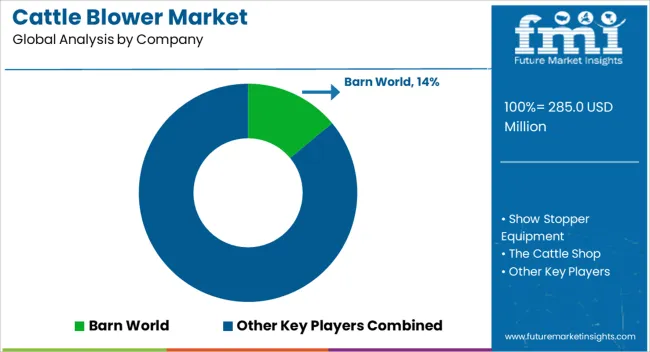
The global cattle blower market is estimated to be valued at USD 285.0 million in 2025.
The market size for the cattle blower market is projected to reach USD 468.7 million by 2035.
The cattle blower market is expected to grow at a 5.1% CAGR between 2025 and 2035.
The key product types in cattle blower market are high pressure, low pressure and medium pressure.
In terms of motor, two motor segment to command 58.2% share in the cattle blower market in 2025.






Full Research Suite comprises of:
Market outlook & trends analysis
Interviews & case studies
Strategic recommendations
Vendor profiles & capabilities analysis
5-year forecasts
8 regions and 60+ country-level data splits
Market segment data splits
12 months of continuous data updates
DELIVERED AS:
PDF EXCEL ONLINE
Cattle and Sheep Disease Diagnostic Kits Market Size and Share Forecast Outlook 2025 to 2035
Cattle Feed Market Analysis - Size, Share, and Forecast Outlook 2025 to 2035
Cattle Squeeze Market Size and Share Forecast Outlook 2025 to 2035
Cattle Feeder Panels Market Size and Share Forecast Outlook 2025 to 2035
Cattle Head Catch Market Size and Share Forecast Outlook 2025 to 2035
Cattle Grooming Chute Market Size and Share Forecast Outlook 2025 to 2035
Cattle Handling Systems Market Size and Share Forecast Outlook 2025 to 2035
Cattle Mineral Feeder Market Size and Share Forecast Outlook 2025 to 2035
Cattle Feeder Market Size and Share Forecast Outlook 2025 to 2035
Cattle Management Software Market Size and Share Forecast Outlook 2025 to 2035
Cattle Supplies Market Analysis & Forecast for 2025 to 2035
Cattle Nutrition Market Analysis by Cattle Type, Nutrition Type, Application, Life Stage Through 2025 to 2035
Smart Cattle Market
Dairy Cattle Feed Market
Automatic Cattle Waterer Market – Trends & Growth Forecast 2025 to 2035
Wall Blower Market Size and Share Forecast Outlook 2025 to 2035
HVAC Blower and Fan Systems Market Growth - Trends & Forecast 2025 to 2035
Bubble Blower Market Size and Share Forecast Outlook 2025 to 2035
High Speed Blowers Market Size and Share Forecast Outlook 2025 to 2035
Regenerative Blowers Market Growth – Trends & Forecast 2025 to 2035

Thank you!
You will receive an email from our Business Development Manager. Please be sure to check your SPAM/JUNK folder too.
Chat With
MaRIA